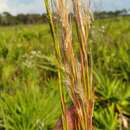Comprehensive Description
provided by North American Flora
Andropogon longiberbis Hack. Flora 68 : 131. 1885
Sorgum longiberbe Kuntze, Rev. Gen. 792. 1891.
Stems tufted, 5-10 dm. tall, the branches in I's-S's; leaf-sheaths, especially those on the innovations, appressed-hirsute with silky hairs, shorter than the internodes; blades 5 dm. long or less, up to 7 mm. wide, those on the innovations densely appressed-hirsute, those on the stem more or less so beneath, rough above; spathes 3-5 cm. long, usually considerably exceeding the racemes, commonly brown; racemes in pairs, rarely in 3's or 4's, 3-4 cm. long, stout; sessile spikelet 4-4.5 mm. long, pale, about twice as long as the stout rachis-internodes, the first scale hispid on the keels, the fourth scale shortly 2-toothed, bearing a straight or nearly straight awn 12-16 mm. long; pedicellate spikelet a subulate scale, or wanting, the pedicel rather stout and a little exceeding the sessile spikelet.
Type locality : Florida.
Distribution: Florida.
- bibliographic citation
- George Valentine Nash. 1912. (POALES); POACEAE (pars). North American flora. vol 17(2). New York Botanical Garden, New York, NY
Physical Description
provided by USDA PLANTS text
Perennials, Terrestrial, n ot aquatic, Rhizomes present, Stems nodes swollen or brittle, Stems erect or ascending, Stems geniculate, decumbent, or lax, sometimes rooting at nodes, Stems caespitose, tufted, or clustered, Stems terete, round in cross section, or polygonal, Stem internodes solid or spongy, Stems with inflorescence less than 1 m tall, Stems with inflorescence 1-2 m tall, Stems, culms, or scapes exceeding basal leaves, Leaves mostly basal, below middle of stem, Leaves mostly cauline, Leaves conspicuously 2-ranked, distichous, Leaves sheathing at base, Leaf sheath mostly open, or loose, Leaf sheath smooth, glabrous, Leaf sheath hairy, hispid or prickly, Leaf sheath and blade differentiated, Leaf blades linear, Leaf blades 2-10 mm wide, Leaf blades mostly flat, Leaf blade margins folded, involute, or conduplicate, Leaf blades more or less hairy, Ligule present, Ligule an unfringed eciliate membrane, Ligule a fringed, ciliate, or lobed membrane, Inflorescence terminal, Inflorescence solitary , with 1 spike, fascicle, glomerule, head, or cluster per stem or culm, Inflorescence a panicle with narrowly racemose or spicate branches, Inflorescence with 2-10 branches, Inflorescence branches paired or digitate at a single node, Inflorescence branches paired racemes, V-shaped, Flowers bisexual, Flowers unisexual, Spikelets pedicellate, Spikelets sessile or subsessile, Spikelets laterally compressed, Inflorescence or spikelets partially hidden in leaf sheaths, subtended by spatheole, Spikelet less than 3 mm wide, Spikelets with 2 florets, Spikelets paired at rachis nodes, Spikelets in paired units, 1 sessile, 1 pedicellate, Pedicellate spikelet rudimentary or absent, usually sterile, Spikelets bisexual, Spikelets unisexual, Inflorescence disarticulating between nodes or joints of rachis, rachis fragmenting, Spikelets disarticulating below the glumes, Spikelets falling with parts of disarticulating rachis or pedicel, Glumes present, empty bracts, Glumes 2 clearly present, Glumes equal or subequal, Glumes equal to or longer than adjacent lemma, Glumes keeled or winged, Glume surface hairy, villous or pilose, Lemmas thin, chartaceous, hyaline, cartilaginous, or membranous, Lemma 1 nerved, Lemma 3 nerved, Lemma glabrous, Lemma apex dentate, 2-fid, Lemma distinctly awned, more than 2-3 mm, Lemma with 1 awn, Lemma awn 1-2 cm long, Lemma awn 2-4 cm long or longer, Lemma awn from sinus of bifid apex, Lemma awns straight or curved to base, Lemma margins thin, lying flat, Lemma straight, Callus or base of lemma evidently hairy, Callus hairs shorter than lemma, Stamens 1, Styles 2-fid, deeply 2-branched, Stigmas 2, Fruit - caryopsis.

